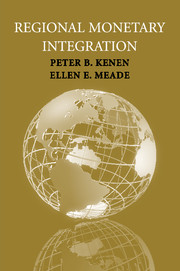Book contents
- Frontmatter
- Contents
- Tables, Boxes, and Chart
- Acronyms
- Acknowledgments
- 1 Introduction
- 2 The Forms, Costs, and Benefits of Currency Consolidation
- 3 The European Monetary Union
- 4 Monetary Arrangements and Economic Performance
- 5 Monetary Union in the Americas?
- 6 Monetary Integration in East Asia?
- 7 The Outlook and Implications for the United States
- References
- Index
3 - The European Monetary Union
Published online by Cambridge University Press: 16 January 2010
- Frontmatter
- Contents
- Tables, Boxes, and Chart
- Acronyms
- Acknowledgments
- 1 Introduction
- 2 The Forms, Costs, and Benefits of Currency Consolidation
- 3 The European Monetary Union
- 4 Monetary Arrangements and Economic Performance
- 5 Monetary Union in the Americas?
- 6 Monetary Integration in East Asia?
- 7 The Outlook and Implications for the United States
- References
- Index
Summary
INTRODUCTION
The European Monetary Union is without question the most ambitious project of its type. A group of highly developed countries with sophisticated monetary systems managed by some of the world's best-known central banks agreed to substitute a single European currency for their own national currencies and to subordinate their own countries' central banks to a new institution – the European Central Bank.
Why and how did this happen? Economists and political scientists have given many reasons. Some of them have focused on problems internal to the EU itself – the threat to the stability of the EMS posed by the adoption of the Single European Act, which required the ending of all capital controls in 1990. Once that had happened, it was argued, the EMS would face the risk of massive speculation against its weakest currencies. The freeing of capital movements, it was said, would force the EU countries to choose between a “retreat” to greater exchange-rate flexibility or an “advance” to full-fledged monetary union.
Politics also played a role in the decision to move to EMU. A single European currency could challenge the hegemony of the U.S. dollar and give a larger role to the EU in managing the world's monetary system. There had for years been discontent, especially in Europe, with U.S. dominance of the international monetary system, what Charles de Gaulle had once described as the “exorbitant privilege” of the United States – its freedom to finance its balance-of-payments deficits in its own national currency.
- Type
- Chapter
- Information
- Regional Monetary Integration , pp. 41 - 79Publisher: Cambridge University PressPrint publication year: 2007

